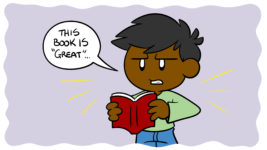The thing about telling stories – the reason everyone thinks they’d make a great writer – is that we all do it, and we tend to do it pretty frequently. We don’t, for instance, all communicate by painting. Few of us regularly sing for an audience, most of us haven’t made anyone a film, but using words to try and communicate a compelling narrative that someone else will appreciate… heck, I think I already did that three times today.
In our everyday lives, we call these little stories anecdotes – an account of an event or activity that is, at the bare minimum, worth recounting to another person. Maybe it’s the fascinating anecdote of your car accident, maybe it’s a recap of recent events intended to keep a friend in the loop, or maybe it’s a frankly tedious account of your trip to the store.
But even the most minor anecdote is a story – a story generally written on the fly and for a tiny audience, but a story nonetheless – and while the rules of storytelling can be bent, they can also be scaled down.
That’s why, in today’s article, we’ll be looking at how to improve your anecdotes. Primarily, our focus will be on treating the anecdote as a microcosm of storytelling in general, but hey, if we make you a more compelling interview subject in the meantime, that won’t hurt your writing career either.
We’ll start by going through some basic rules to telling better micro-narratives (the kind that are worth knowing even if you intend to break them), but the real show is at the end, when we’ll be looking at how the theory we’ve discussed pertains to perhaps the best anecdote ever told (definitely top ten). Before that treat, however, let’s put in the work to earn it.
Rule 1: Don’t waste your audience’s time
We’ll start with the most obvious flaw you’re likely to run into with an anecdote: telling a story that’s a waste of your listener’s time. Now, the bar for anecdotes is pretty low. We use anecdotes to stay informed and to build or maintain intimacy, so sometimes even a pretty poor story has merit, but not every story has merit. Some stories may be fun for you to tell without having any value to the person who has to hear them.
When you tell a story, do so with the intent to provide an experience for the other person. This experience doesn’t have to change their lives, but it does have to have at least the potential to provide a better experience than if they’d never heard it.
Yes, this is basic advice, but it’s incredibly easy to forget. We are all the main characters in our own stories but, for other people, we range from supporting cast to faces in the background. We are capable of valuing an experience simply because it happened to us, but when we tell a story on that basis, we’ve already lost the factor that made it relevant. Can that story still stand on its own without total investment in the feelings, thoughts, and future of the main character? If not, it’s not worth telling, whether as an anecdote or an epic, five-book series.
So, don’t waste the reader’s time, but beyond checking your ego, how can you make sure a story is worth telling?
Rule 2: Check your assumptions
Good writing isn’t just fan-service, but it does take its intended reader into account. You wouldn’t, for instance, write your story in French if your audience couldn’t read French (or, if you did, you’d be wrong to feel surprised when no-one liked your story).
Communicating with the reader is a skill, and it will improve as you experiment with your storytelling, but a great place to start is by checking your assumptions. We already covered the most important assumption: that your reader is already interested. If you assume they want to hear your story and they don’t, you just missed your chance to add something that grabs their interest. In stories, there are a hundred ways to do this, but one example for an anecdote would be starting with a hook. Instead of beginning your story, “Last week, I went to buy some jeans…” consider “Did I tell you I got screamed at by a security guard last week? Okay, so I went to buy some jeans…”
Another consideration is your listener’s worldview. If they have different moral priorities than you, it may be that they experience your story in a very different way than you intend. That doesn’t have to ruin the story, but again it’s about your artistic choices – knowing they think differently than you can help you make your story more entertaining, persuasive, or even more acutely irritating (if that’s what you want).
A final consideration is whether your reader has all the information they need to understand the story. If you start telling a story about ‘Tom,’ are you sure they know which Tom you’re talking about? And I mean: are you really sure? I know you told them that amazing Tom story in May, but since you’re not the main character in their life, are you totally sure they have an encyclopedic knowledge of your supporting cast? The same logic applies to longer stories; you know this world inside-out, but the reader is new here.
This isn’t the only way in which stories can be unclear…
Rule 3: Consider structure
A friend of mine carries a note in her purse that reads ‘beginning, middle, end.’ It’s not a reference document so much as a totem – a reminder of her (now conquered) habit of beginning in the middle of the story, peppering in context only when met with confusion, and either getting distracted away from the ending or revealing it too soon, rendering the remainder of the middle a chore.
There are many ways to tell a story, and many authors have done great things by messing with structure, but there’s a reason most stick with ‘beginning, middle, end’; it’s clear. When we haven’t quite identified the point of our story, or when we think only the ending matters, we can get lost in telling a narrative out of order. Before you tell a story, answer these questions:
- Where does this story truly begin?
- What ending am I working towards?
- Which parts of the middle are actually important to move from one to the other?
After that, you may choose to experiment, but identifying these core criteria will help you tell a better story, and they’ll also help you…
Rule 4: Be concise
I get to follow my own rule, here, since the logic behind this rule should be clear from what has come before. Your reader may not be as fascinated as you assume, you shouldn’t waste their time, and your story will probably be better if it’s structured for their interest. So… be concise. Make it a rule to avoid tangents: if they’re genuinely interesting, you can come back to them later, and if they’re not, you don’t want them in the first place.
Rule 5: Own what you’re saying
Just as stories benefit from a consideration of structure, they benefit from a consideration of intent. If you’re telling a story, it has a point, and identifying that point will help you find the best version of the story.
Of course, anecdotes deliver facts, but they also have a philosophical intent. This may sound a little grand, but even the shortest anecdote contains something that was worth mentioning: it suggests that a thing should have happened, shouldn’t have happened, or at least that its happening was remarkable (that is, worthy of remarking upon). In short, all art is political.
Most of the time, those politics don’t matter in anecdotes. Everyday stories employ the type of everyday politics that the people around you are likely to agree with, but there will be exceptions. Tell someone in the service industry how careless your waitress was last night and you may find that they consider you the villain of the piece. Tell your great-grandmother a funny story about a colleague who didn’t know how to find something basic on a search engine and she may not see the funny side. This is because, while you may not have thought you were making a point, you were: ‘My waitress should have provided me with good service’ and ‘My colleague should be able to use a search engine.’ Likewise, in each case, your listener disagreed – the service industry friend remembered all the tough shifts and mean customers they ever had, and your great-grandmother wonders why you think everyone should be able to understand this newfangled technology.
Part of this is, as we discussed, checking your assumptions: is your audience actually in a place to enjoy your story? But that part isn’t possible unless you know what you’re saying. Ever have someone tell you an uncomfortable story where the point boiled down to ‘someone from a group I’m prejudiced against was nice to me’? It’s not just that they assumed you have the same prejudices, it’s that they didn’t really think about the fact that the point of their story was how odd it is that someone from the bad group did something good. Point this out to them and they backtrack – not because that’s not how they feel, but because they never confronted how harsh it sounds when stated directly.
In less uncomfortable situations, not knowing the point of your story can lead you to rambling or being unable to identify the salient details. So, whether you’re writing a story or telling an anecdote, take a minute to identify what it’s actually about. You can make this process easier if you remember that…
Rule 6: Don’t forget the ‘but’
Many people have tried to identify what makes a story a story, but in literary circles, the presence of a ‘but’ is generally accepted as a good criteria.
By this, I mean that a story that progresses ‘I did A, and then B happened, and then C happened’ is likely to be as dull as ditchwater. Why? Because there was no conflict. Things progressed as expected, which means that if your story begins ‘I went to buy some jeans’ and then nothing unexpected happens, everything else you say is a waste of the audience’s time. This turn in the tale isn’t so much the secret to telling a good story as the thing that even makes what you’re saying a story in the first place. The bigger the ‘but,’ the more exciting the story is likely to be, so while only having a tiny ‘but’ isn’t the end of the world, it’s a good cue to at least pause and consider what makes your story interesting.
This is something I described in Your Book Is Crying Out For A Volta – Here’s How To Deliver, so I won’t belabor the point here. One thing that’s worth saying before we move on, however, is that the ‘but’ doesn’t have to be literal. The ‘but’ is merely a moment where the actual path of events diverges from the assumed path of events. So, “My car’s engine suddenly exploded” doesn’t contain a literal ‘but,’ but it’s implied we were all assuming the engine wouldn’t explode (but it did). Most stories about unusual events begin with a silent, “I was expecting to have a normal day, but then…”
Make sure that your stories either live up to this silent ‘but’ or contain one of their own. Again, check your assumptions as you identify your ‘but’ – if I don’t know what a normal day at your workplace looks like, I may not be equipped to understand how unusual your ‘but then…’ is supposed to be.
Rule 7: Draft, redraft, and draft again
Earlier, I said that anecdotes tend to be made up on the fly, buttttttt… not really. Sure, there’s the first time we tell a story, but a good anecdote tends to be told more than once, and we work on it each time we tell it. We add emphasis where the last listener reacted, we cut the parts that bored them, and we clear up anything they had to ask about. In short, we edit.
Or, at least, we should, and we should do so on every level. Just as you’d change how you tell a good anecdote, you need to work on your writing. Because anecdotes are so short, they tend to promote an irreverence that can serve us well with longer work. If part of an anecdote isn’t working, if you’ve started it in the wrong place before, or if one part in particular is getting huge laughs, you’re probably willing to completely restructure your next telling from that feedback. Why? Because that makes it a better story. And, yes, treating a longer piece of writing in this way is a lot more work, but isn’t it also a lot more rewarding?
While committing to a project is admirable, plenty of authors have wasted huge swathes of time trying to rework their first draft, even though they know deep down that it would be better to start the story somewhere else or from a different character’s perspective.
One writing exercise that many sources suggest but few authors use is to rewrite a scene in a different person, tense, or from a different point of view. Why do experts suggest this? Because once you’ve written your first draft, you know your story better, so you’re in a position to make choices you couldn’t before you started. Why do most authors avoid it? Because they don’t want to find out that they’d be better off rewriting the whole thing.
Try to banish this fear from your work. Don’t keep scrapping it year after year, but be willing to truly rethink the form of the thing at least once, just as you would a good anecdote.
And now… an anecdote
The following anecdote is a great example of the form, told in various places by Douglas Adams (author of The Hitchhiker’s Guide to the Galaxy, among other works.)
This actually did happen to a real person, and the real person is me. I had gone to catch a train. This was April 1976, in Cambridge, U.K. I was a bit early for the train. I’d gotten the time of the train wrong. I went to get myself a newspaper to do the crossword, and a cup of coffee and a packet of cookies. I went and sat at a table. I want you to picture this scene. It’s very important that you get this very clear in your mind. Here’s the table, newspaper, cup of coffee, packet of cookies. There’s a guy sitting opposite me, perfectly ordinary-looking guy wearing a business suit, carrying a briefcase. It didn’t look like he was going to do anything weird. What he did was this: he suddenly leaned across, picked up the packet of cookies, tore it open, took one out, and ate it.
Now this, I have to say, is the sort of thing the British are very bad at dealing with. There’s nothing in our background, upbringing, or education that teaches you how to deal with someone who, in broad daylight, has just stolen your cookies. You know what would happen if this had been South Central Los Angeles. There would have very quickly been gunfire, helicopters coming in, CNN, you know… But in the end, I did what any red-blooded Englishman would do: I ignored it. And I stared at the newspaper, took a sip of coffee, tried to do a clue in the newspaper, couldn’t do anything, and thought, ‘What am I going to do?’
In the end I thought, ‘Nothing for it, I’ll just have to go for it,’ and I tried very hard not to notice the fact that the packet was already mysteriously opened. I took out a cookie for myself. I thought, ‘That settled him.’ But it hadn’t, because a moment or two later he did it again. He took another cookie. Having not mentioned it the first time, it was somehow even harder to raise the subject the second time around. “Excuse me, I couldn’t help but notice…” I mean, it doesn’t really work.
We went through the whole packet like this. When I say the whole packet, I mean there were only about eight cookies, but it felt like a lifetime. He took one, I took one, he took one, I took one. Finally, when we got to the end, he stood up and walked away. Well, we exchanged meaningful looks, then he walked away, and I breathed a sigh of relief and sat back.
A moment or two later, the train was coming in, so I tossed back the rest of my coffee, stood up, picked up the newspaper, and underneath the newspaper were my cookies. The thing I like particularly about this story is the sensation that somewhere in England there has been wandering around for the last quarter-century a perfectly ordinary guy who’s had the same exact story, only he doesn’t have the punch line.
– Douglas Adams, ‘Cookies’, The Salmon of Doubt
Now, tastes may vary, but this anecdote (later written down for posterity) tends to get a great reception. How, then, does it stack up according to our rules?
Rule 1: Don’t waste your audience’s time
Adams knows he’s telling a funny story, and he does so skillfully. While he takes his time to build expectation and humor, no part of the story is wasted. The beginning clarifies the scene, the middle builds tension, and then he whips away the ending with a quick punch line. Where was he going on the train? Doesn’t matter. Which newspaper? Doesn’t matter. What type of cookie? Doesn’t matter.
Rule 2: Check your assumptions
Adams does a great job, here. He clearly describes his thought process, helping the reader to stay on the same page, but he also considers cultural differences. Ignoring rude behavior is a normal aspect of British culture, but this isn’t true all over the world, so he addresses this directly. If he didn’t do this, he’d be leaving the door open for the reader to assume he may react as they would, creating possible misunderstandings. Adams also opts for the word ‘cookie.’ In the British lexicon, the equivalent term would be ‘biscuit’ (with cookies being a particular type of biscuit.) Here, Adams doesn’t just choose the word American readers will immediately understand, he chooses one that also won’t trip up British readers back home.
Rule 3: Consider structure
Adams goes for a traditional beginning, middle, and end, and he gets the most out of each. He also chooses to end his story on a high – he doesn’t allow the ending to overstay its welcome, and he adds an unusual observation in order to sign off on a big, new laugh.
Rule 4: Be concise
Yup.
Rule 5: Own what you’re saying
Here, I personally think Adams fails. His comments about ‘South Central Los Angeles’ are obvious exaggeration, but they draw on a stereotype he’s assuming his audience gets and supports. Is the story’s humor improved to the same extent that some readers’ investment is lost? Maybe at the time, with a given audience, but if I was his editor now, I’d suggest the story is stronger without this.
Otherwise, Adams’ story is a classic self-deprecating narrative. He’s the one who misunderstood the situation, and so he’s the butt of the joke. This is a strength not because it makes the story ‘nicer,’ but because it allows him near-total control over context. The story mocks his own misunderstanding, and he’s giving you permission to see it the same way he does, so audience retention is maximized – there are few reasons not to see it from his perspective.
Rule 6: Don’t forget the ‘but’
This story has two. The ordinary ‘I was expecting to have a normal day, but then somebody did something unusual’ and then the far superior, ‘I thought the other person was behaving badly, but it turned out I’d completely misunderstood!’
Adams is aware of his ‘but’ and makes it stronger by ensuring the reader realizes what happened right when he wants them to. He’s sure enough of this realization that he never actually has to explain ‘I thought the other man’s pack of cookies was my own.’ That realization takes place in the reader’s head, and the story is better for it.
Rule 7: Draft, redraft, and draft again
‘It’s very important that you get this very clear in your mind. Here’s the table, newspaper, cup of coffee, packet of cookies.’ These are not the words of someone who is telling this story for the first time, but rather someone who has considered where they need the reader to be for the ‘punch line’ to land as successfully as possible.
Did I ever tell you…
So, those are seven rules for telling better anecdotes (and writing better stories). Rules are, of course, made to be broken, but you’ll break them more effectively if you know what they are.
Having a few anecdotes on hand never hurts, so if you want some free, easy, useful writing practice, try working on a given anecdote as you would a story. Try it out on unsuspecting beta listeners, tailor it according to their (likely unspoken) feedback, and find the best form of the story.
What did you notice about Adams’ story that I didn’t mention? Do any better anecdotes spring to mind? Let me know in the comments, and check out So You Think You Know Your Short Prose?, How To Write A Killer Short Story, and Writing Creative Nonfiction – How To Stay Safe (And Legal) for more great advice on this topic.





